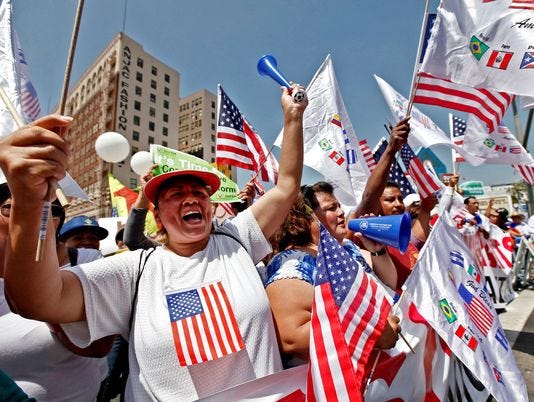David Agren, Special for USA TODAY
1:56 a.m. EDT May 2, 2013
 CHILPANCINGO, Mexico — Protesters armed with pipes, spray paint and
slingshots marched through this state capital south of Mexico City,
vandalizing public buildings to express opposition to teacher competency
exams and the revoking of the right to sell their jobs to the highest
bidder.
CHILPANCINGO, Mexico — Protesters armed with pipes, spray paint and
slingshots marched through this state capital south of Mexico City,
vandalizing public buildings to express opposition to teacher competency
exams and the revoking of the right to sell their jobs to the highest
bidder.Unions in Greece, where government jobs have been cut because of overspending of taxpayer money, held a strike that brought ferry and train services to a halt.
"We are here to send a message to … those in power in Europe, that we will continue our struggle against unfair, open-ended policies that are destroying millions of jobs," said Kostas Tsikrikas, leader of Greek public sector labor union ADEDY.
More than 100,000 Spaniards angry at budget cuts and higher taxes imposed to solve a nationwide budget deficit took to the streets in 80 cities. Under banners reading "Fight for your rights," union leaders called on the government to reverse its austerity drive.
May Day events in Turkey turned violent when some demonstrators threw stones and gasoline bombs at police. Security forces used water cannon and tear gas to prevent crowds from accessing Taksim Square.
But it was Mexico, the protests were criticized by residents who accuse teachers of focusing more on leftist politics than helping change a school system that fails to educate children adequately.
"There's Marxism in all of the teaching, right from the start," teacher Arturo Castaño says of his alma mater, the Escuela Normal Rural Raúl Isidro Burgos, which takes pride in having produced teachers that have gone on to participate in guerrilla movements.
President Enrique Peña Nieto introduced measures — now enacted — shortly after taking office Dec. 1, to improve teaching in a school system whose students receive some of the lowest scores on standardized exams.
Many residents in Chilpancingo expressed frustration with the teachers, saying they've had to make other arrangements for their children or enroll them in private schools.
"There are some good public school teachers, but a lot of bad ones that don't have the proper training," Esther Cruz, a stationary shop employee and mother of three, says.
Teachers in this state, which spreads south of Mexico City across marginalized mountainous regions, argue that the changes stealthily "privatize" education by imposing fees on poor parents. They insist the exam process is a trick to fire teachers and them hire them back on hourly salaries without full benefits.
"This has nothing to do with education. it's an administrative measure," 30-year veteran teacher Román López, says of the changes. "We have dilapidated school infrastructure (in Guerrero) and the education reform does nothing to fix that."
The former head of the 1.4 million member National Education Workers Union, Elba Esther Gordillo, has been accused of embezzling approximately $200 million in union money spent in part on a luxury home in Coronado, Calif., and shopping sprees at Neiman Marcus.
Teachers in Guerrero have forced the local governor, Ángel Aguierre, to back down and propose a different version of an education reform to be applied locally.
They've kept up the pressure with protests, which included burning the headquarters of four political parties, storming the state congress, surrounding stores such as Wal-Mart and blocking the busy Acapulco-Mexico City highway. Teachers encouraged their students to join in the acts.
Castaño says the leftist curriculum in some regions is a way of addressing the difficulties of rural Mexico, where poverty is pervasive and many work for low wages picking sugar cane and tomatoes in northern states. Students arrive at school hungry and the infrastructure is so lacking that kids bring buckets to school for fetching water from a nearby creek for cleaning and drinking.
Parents pitch in money, Castaño says, to pay the school's monthly electricity bill.
Elsewhere, in Indonesia, tens of thousands of workers rallied for higher pay and other demands. Some carried banners reading: "Sentence corruptors to death and seize their properties" to protest a proposal for the government to slash fuel subsidies that have kept the country's pump prices among the cheapest in the region.
In the Philippines, 8,000 workers marched in Manila to demand more pay and regular jobs instead of contractual work. Some rallied outside the U.S. Embassy, torching a wooden painting stamped with the words "low wages" and "union busting" that depicted Philippine President Benigno Aquino III as a lackey of President Obama.
More than 10,000 Taiwanese protested a government plan to cut pension payouts to solve worsening fiscal problems. In Cambodia, more than 5,000 garment workers marched in Phnom Penh, demanding better working conditions and a salary increase.
In Havana, tens of thousands of Cubans joined the communist nation's traditional May Day march in the Plaza of the Revolution. This year's event was dedicated to Cuba's ally, the late Venezuelan leader Hugo Chávez.
